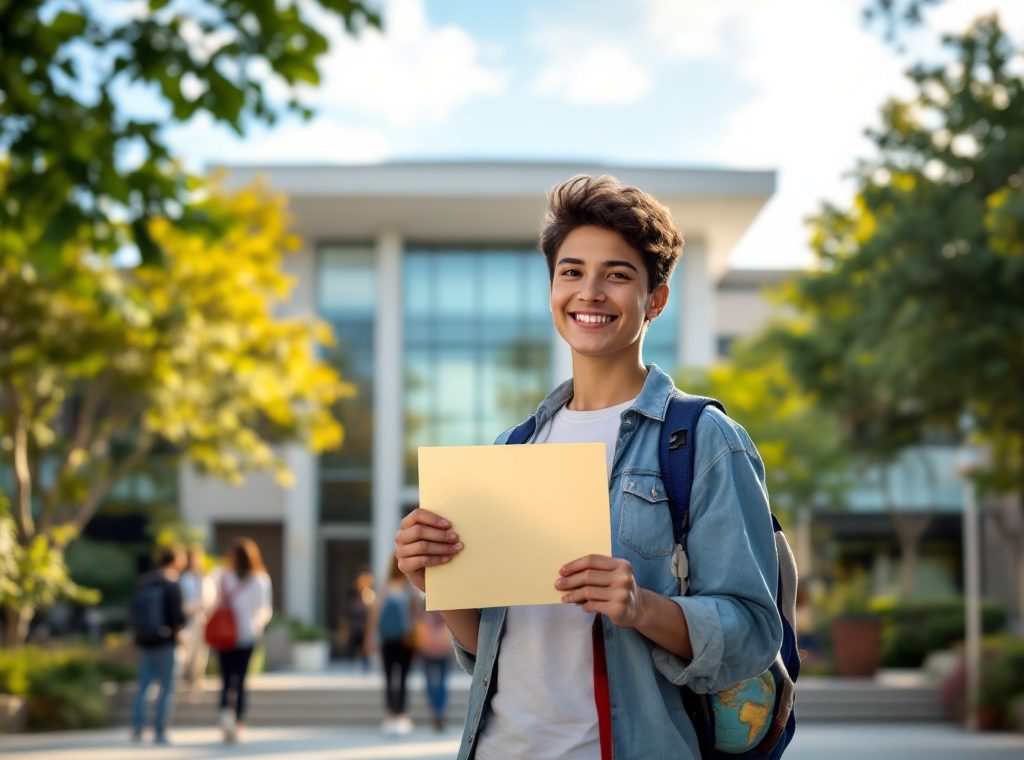Requirements for a Student Visa
Dreaming of studying abroad? Securing a student visa is the first step. This comprehensive guide outlines crucial requirements, from acceptance at a Student and Exchange Visitor Program (SEVP)-certified school to demonstrating financial stability and English proficiency. Learn about F-1 and M-1 visas, understand the application process, ace your interview, and maintain your visa status. Start your international education journey now!
Important information

- Acceptance into an SEVP-certified school is required for a student visa.
- You must prove you have enough money for tuition and living costs.
- A valid passport, the DS-160 form, and the I-20 form are essential parts of the process.
- Prepare for your visa interview by practicing answers about your academic goals, financial stability, and plans after graduation.
- Maintain your visa status by keeping up good grades, following work restrictions, and renewing your I-20 before it expires.
Understanding the Requirements for a Student Visa
Secure acceptance into a recognized educational institution. This is a fundamental requirement for your student visa application.
Demonstrate your financial capacity. You must show you can cover your tuition fees and living expenses during your studies.
Ensure you have a valid passport. This is mandatory for international travel and visa applications.
Complete the required visa application. For example, F-1 visa applicants need to complete the DS-160 form.
Demonstrate English language proficiency. Most institutions require proof of your English skills through tests like TOEFL or IELTS.
Show your intention to return home after completing your studies. This is crucial to assure visa officers that you don’t intend to immigrate.
Attend a visa interview and undergo necessary background checks. These are standard procedures in most student visa applications.
Provide specific health information if required. Some countries may require vaccination records or proof of health insurance.
Research your destination’s specific visa rules. Visa requirements vary by country, so thorough research is essential for a smooth application process.
Types of Student Visas
The US offers several student visa options. The F-1 visa is designed for students pursuing academic studies, such as college or university degrees. The M-1 visa caters to those seeking vocational training and non-academic programs. A crucial requirement for both visas is enrollment at a Student and Exchange Visitor Program (SEVP)-certified institution, which signifies US government approval.
F-1 Visa for Academic Studies
International students pursuing academic studies in the U.S. need an F-1 visa.
This requires acceptance into a Student and Exchange Visitor Program (SEVP)-certified institution, such as a college or university.
A valid passport and proof of sufficient funds for tuition and living expenses are also essential.
M-1 Visa for Vocational Studies
The M-1 visa allows students to pursue vocational training in the United States. Similar to the F-1 visa, it has specific regulations that must be followed.
Eligibility Rules for a Student Visa
Get accepted into an SEVP-certified school. You must be accepted into a school certified by the Student and Exchange Visitor Program (SEVP).
Enroll full-time. Full-time enrollment is mandatory for a student visa.
Demonstrate English proficiency. You will likely need to prove your English language abilities, often through standardized tests.
Provide financial documentation. You must show you have sufficient funds to cover your tuition fees and living expenses during your studies.
Have a valid passport. A valid passport is a must-have for international travel and visa applications.
Enrolling in SEVP-Approved Schools
International students applying for F-1 or M-1 visas should select SEVP-certified schools. This certification signifies that the institution meets stringent US government standards for educational quality and program integrity.
Maintaining Full-Time Student Status
Full-time enrollment is required every term. Students must maintain a good GPA to remain in good academic standing. These requirements can vary by school and visa type.
Demonstrating English Proficiency
Student visa applicants often need to demonstrate English language proficiency. TOEFL and IELTS are widely accepted, but some institutions may also accept the following:
- alternative qualifications, such as their own internal assessments,
- previous study in English-medium programs.
Prospective students should confirm specific requirements with their chosen institution and the relevant country’s visa authorities.
Providing Proof of Sufficient Funds
Securing a student visa requires demonstrating your ability to cover tuition and living expenses. Provide evidence of readily available funds, such as:
- bank statements,
- scholarship letters,
- an affidavit of support from a sponsor.
These documents validate your financial capacity.
The Visa Application Process
Complete the online DS-160 nonimmigrant visa application and print the confirmation page for your visa interview.
Obtain Form I-20, your Certificate of Eligibility for Nonimmigrant Student Status, from your SEVP-certified school after acceptance. This document confirms your eligibility to study in the US and includes important details like your SEVIS ID, program specifics, and dates.
Pay the mandatory I-901 SEVIS fee, which supports the Student and Exchange Visitor Information System (SEVIS). All F and M visa applicants must pay this fee and, like the DS-160 confirmation, bring proof of payment to their interview.
Completing the DS-160 Visa Application
International students seeking an F-1 visa must complete the online DS-160 form. This form requests personal information and details about your intended studies. It’s a crucial step in the F-1 visa application process.
Obtaining and Using Form I-20
After your SEVP-certified school accepts you, the Designated School Official (DSO) will issue Form I-20, your “Certificate of Eligibility for Nonimmigrant Student Status”. This vital document not only confirms your acceptance but also provides essential information, such as your SEVIS ID, program dates, and estimated costs. You’ll need this form to pay the I-901 SEVIS fee, apply for your student visa, and enter the United States. It’s also crucial for maintaining your student status throughout your studies, so keep it safe and readily available.
Get accepted by your SEVP-certified school.
Receive Form I-20 (“Certificate of Eligibility”) from your DSO, containing your SEVIS ID, program details, and cost estimates.
Use Form I-20 to pay the I-901 SEVIS fee.
Apply for your student visa using Form I-20.
Present Form I-20 upon entering the United States.
Keep Form I-20 safe and accessible throughout your studies to maintain your student status.
Paying the I-901 SEVIS Fee
Before paying the I-901 SEVIS fee, students need Form I-20. This form, issued by their Designated School Official (DSO), confirms acceptance into a Student and Exchange Visitor Program (SEVP)-certified school. Obtaining the I-20 is crucial, as it is a prerequisite for SEVIS fee payment.
Preparing for the Visa Interview
Preparing for your visa interview involves several key steps.
Schedule your interview and gather all required documents. This includes your school acceptance letter, financial records, and academic transcripts. Check the specific requirements for your visa type, as additional documents may be needed.
Consider potential interview questions beforehand. The interview allows consular officers to assess your qualifications and intentions. Be prepared to discuss your study plans, financial stability, and post-graduation plans thoroughly.
Be ready to explain how you will finance your education. Financial stability is a key factor in visa approvals.
Have a clear answer prepared regarding your post-graduation plans. Consular officers will inquire about your intentions after completing your studies.
Thorough preparation significantly increases your chances of a successful visa interview and approval.
Scheduling and Attending the Interview
After completing the DS-160 form and paying the SEVIS fee, schedule your visa interview. This is an in-person interview where you should be prepared to discuss your academic goals.
Documents to Bring to the Interview
Bring your Form I-20 and a valid passport to your visa interview.
Demonstrate your financial resources by bringing proof of funds.
Bring supplementary documents such as academic transcripts and standardized test scores.
Include any other supporting materials that can strengthen your application.
Common Interview Questions
Be ready to discuss your academic interests, including your preferred program and your reasons for selecting this university.
Be prepared to share your long-term career goals.
Funding is key, so expect questions about your financial resources, such as savings, family support, and scholarships. Be prepared to share details.
Explain your ties to your home country and why you plan to return after completing your studies. This demonstrates your commitment to your home country.
Financial Documentation and Proof of Funds
We accept various financial documents, including:
- bank statements, which demonstrate your available funds,
- scholarship letters, which confirm your school funding,
- affidavits of support, which identify your sponsor.
The required amount depends on your program’s length and your school’s costs. Your I-20 form details these estimated yearly expenses, making it crucial for financial planning.
Types of Acceptable Financial Documents
Gather necessary financial documents. To secure a student visa, you must demonstrate your financial capacity to cover tuition and living expenses. Acceptable proof includes bank statements, scholarship letters, and affidavits of support.
Provide bank statements. Bank statements offer a detailed record of your recent transactions and account balances, verifying available funds.
Submit scholarship letters (if applicable). Scholarship letters confirm financial aid from educational institutions or other organizations.
Include affidavits of support (if necessary). Affidavits of support demonstrate sponsorship from another individual.
Ensure documentation clarity. All submitted documentation must clearly establish sufficient funds for both academic and living costs.
Calculating Required Financial Amounts
To obtain a visa, you need to calculate your total education expenses. This includes tuition, living costs, and any additional fees. Presenting this total amount to visa officials confirms your financial capacity to support yourself during your studies.
Maintaining Student Visa Status
Maintaining a valid student visa requires adherence to specific regulations set by your educational institution and your host country’s immigration authorities. These rules encompass academic performance, work authorization, and visa renewal procedures.
Academic Performance
Students must maintain satisfactory grades, often meeting a minimum GPA requirement. Failure to meet these standards can jeopardize your visa status.
Work Authorization
Part-time, on-campus employment is typically permitted during the academic term. Off-campus work opportunities may be available under specific circumstances, such as demonstrable financial hardship or participation in approved training programs.
Visa Renewal: Start Early
Visa renewal processes vary depending on the country and the type of visa held. It’s crucial to initiate the renewal process well in advance of your visa’s expiration date.
Gather Required Documentation
Typically, you’ll need updated financial documentation, proof of continued enrollment, and evidence of compliance with existing visa regulations.
Consequences of Visa Expiration
Failure to maintain a valid visa can result in visa revocation and potential deportation.
Academic Standing and GPA Requirements
Maintaining good academic standing is crucial for international students with F-1 or M-1 visas. A low GPA can jeopardize your visa status, potentially leading to its termination. Each academic program sets its own GPA requirements, so contact your Designated School Official (DSO) for specific details. While visa reinstatement may be possible, it requires documentation explaining academic difficulties and a concrete plan for improvement. This plan should outline how you intend to raise your grades and regain good academic standing.
Work Eligibility and Restrictions
F-1 visa students can work on campus up to 20 hours weekly during the academic year, but full-time during breaks and holidays. Off-campus work may be possible after the first academic year, particularly for students experiencing unforeseen financial difficulties. Curricular Practical Training (CPT) and Optional Practical Training (OPT) provide additional work opportunities. OPT offers temporary authorization for jobs related to the student’s field of study. Specifically, CPT allows students to gain practical experience through paid or unpaid internships, cooperative education, or other employment directly related to their major field of study.
Visa Renewal and Extension
Obtain a new I-20. Contact your Designated School Official (DSO) to request a new I-20 form before your current one expires.
Complete the visa application process. Once you have the new I-20, proceed with the F-1 visa renewal or extension application.
Maintain your legal status. It’s crucial to maintain your legal status in the U.S. to avoid potential complications.
Consult your DSO for guidance. Your DSO can provide valuable support and guidance throughout the renewal or extension process.
Your F-1 student visa is directly tied to your I-20 form, so it’s essential to renew your I-20 before it expires. While reinstatement is possible if your status lapses, it’s a complex process. Proactive renewal is always the best approach.












